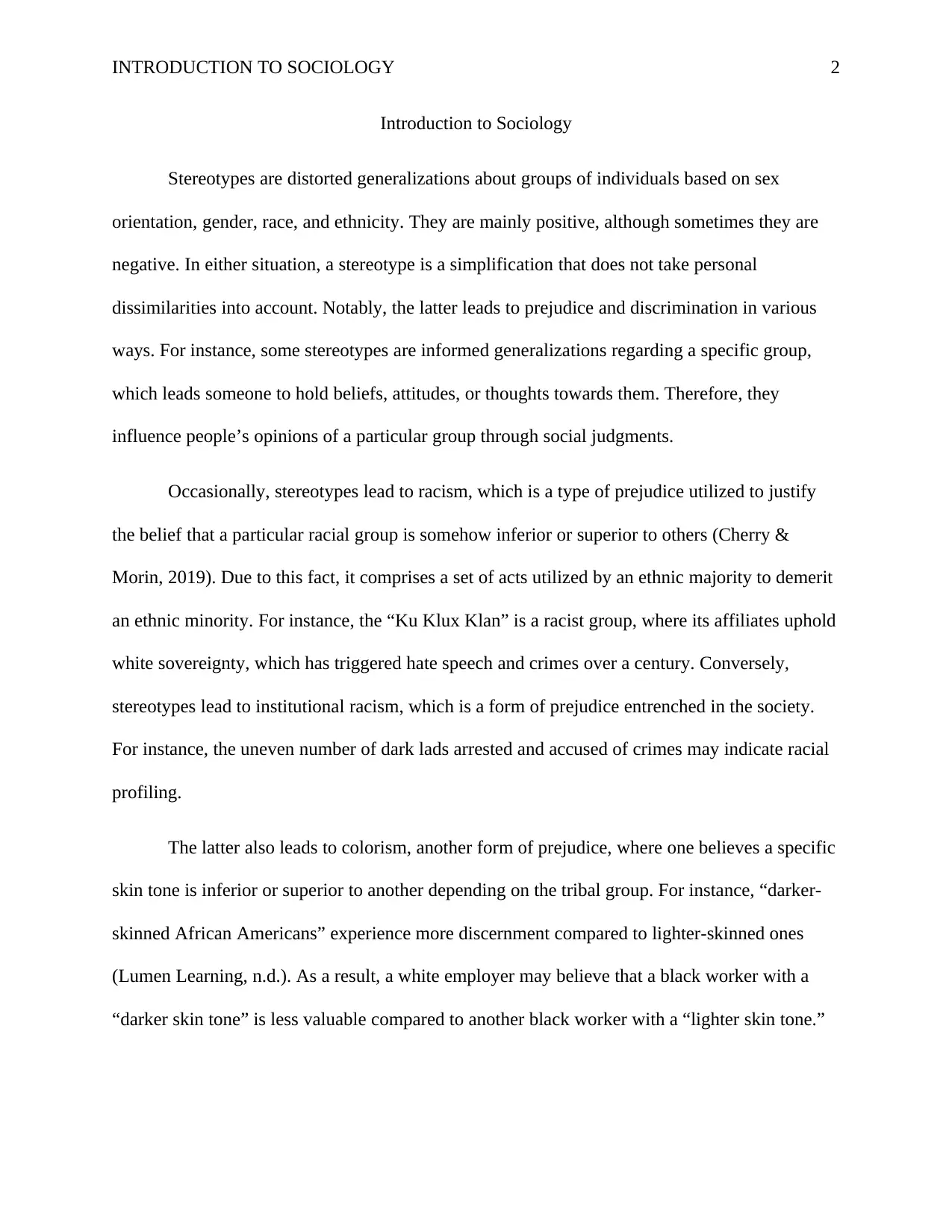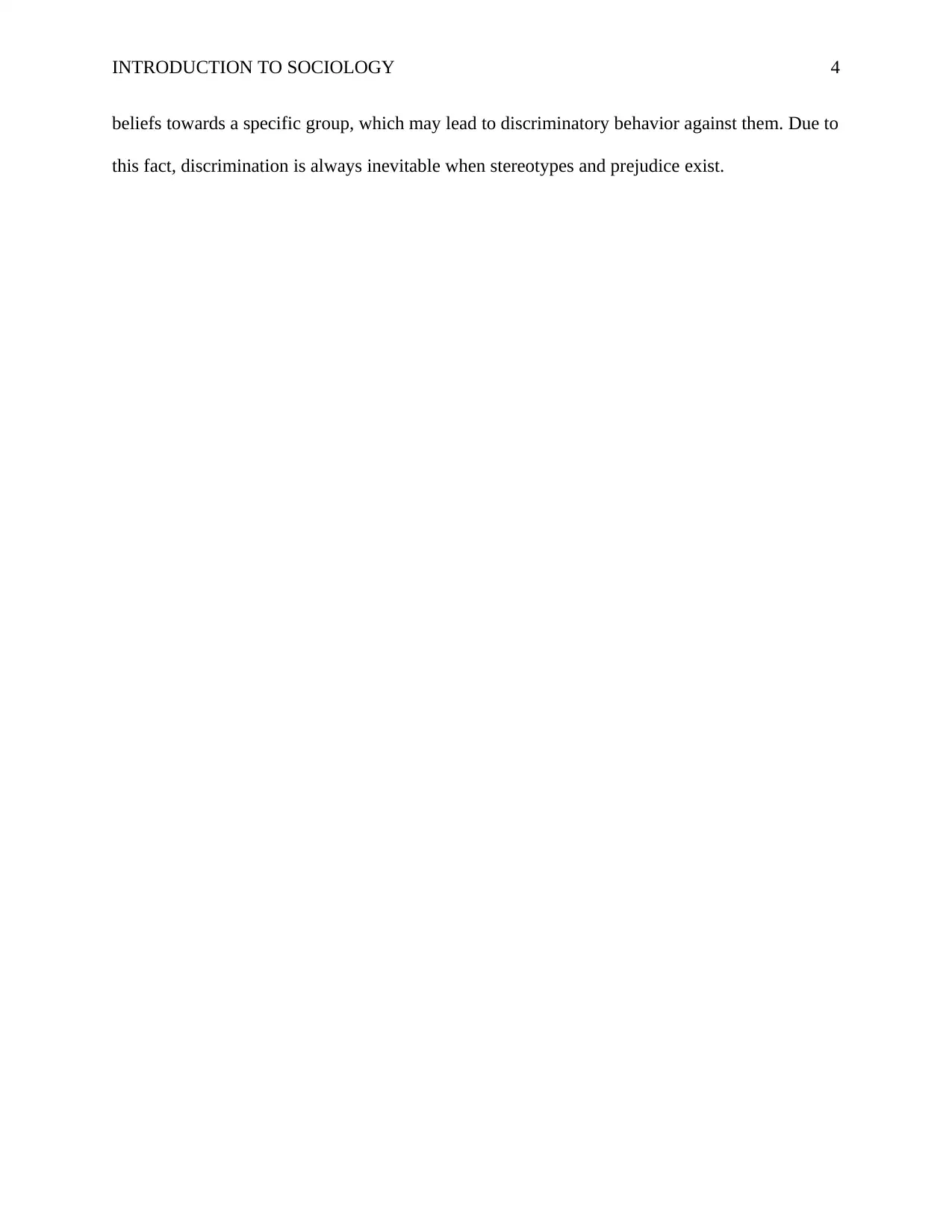Sociology Essay: Stereotypes, Prejudice, and Discrimination
VerifiedAdded on 2022/08/16
|5
|782
|10
Essay
AI Summary
This essay provides an introduction to the sociological concepts of stereotypes, prejudice, and discrimination. It begins by defining stereotypes as generalizations based on characteristics like race, gender, and ethnicity, which can lead to prejudice and discrimination. The essay explores how stereotypes influence opinions and can result in racism, as exemplified by groups like the Ku Klux Klan, and institutional racism, such as racial profiling. It also discusses colorism and how these biases lead to discriminatory behaviors, including avoiding or excluding certain groups. The essay concludes that stereotypes and prejudice contribute to social inequality and that discrimination is a direct consequence of these biases. References to relevant sources support the arguments presented.

Running head: INTRODUCTION TO SOCIOLOGY 1
Introduction to Sociology
Student’s Name
Institutional Affiliation
Introduction to Sociology
Student’s Name
Institutional Affiliation
Paraphrase This Document
Need a fresh take? Get an instant paraphrase of this document with our AI Paraphraser

INTRODUCTION TO SOCIOLOGY 2
Introduction to Sociology
Stereotypes are distorted generalizations about groups of individuals based on sex
orientation, gender, race, and ethnicity. They are mainly positive, although sometimes they are
negative. In either situation, a stereotype is a simplification that does not take personal
dissimilarities into account. Notably, the latter leads to prejudice and discrimination in various
ways. For instance, some stereotypes are informed generalizations regarding a specific group,
which leads someone to hold beliefs, attitudes, or thoughts towards them. Therefore, they
influence people’s opinions of a particular group through social judgments.
Occasionally, stereotypes lead to racism, which is a type of prejudice utilized to justify
the belief that a particular racial group is somehow inferior or superior to others (Cherry &
Morin, 2019). Due to this fact, it comprises a set of acts utilized by an ethnic majority to demerit
an ethnic minority. For instance, the “Ku Klux Klan” is a racist group, where its affiliates uphold
white sovereignty, which has triggered hate speech and crimes over a century. Conversely,
stereotypes lead to institutional racism, which is a form of prejudice entrenched in the society.
For instance, the uneven number of dark lads arrested and accused of crimes may indicate racial
profiling.
The latter also leads to colorism, another form of prejudice, where one believes a specific
skin tone is inferior or superior to another depending on the tribal group. For instance, “darker-
skinned African Americans” experience more discernment compared to lighter-skinned ones
(Lumen Learning, n.d.). As a result, a white employer may believe that a black worker with a
“darker skin tone” is less valuable compared to another black worker with a “lighter skin tone.”
Introduction to Sociology
Stereotypes are distorted generalizations about groups of individuals based on sex
orientation, gender, race, and ethnicity. They are mainly positive, although sometimes they are
negative. In either situation, a stereotype is a simplification that does not take personal
dissimilarities into account. Notably, the latter leads to prejudice and discrimination in various
ways. For instance, some stereotypes are informed generalizations regarding a specific group,
which leads someone to hold beliefs, attitudes, or thoughts towards them. Therefore, they
influence people’s opinions of a particular group through social judgments.
Occasionally, stereotypes lead to racism, which is a type of prejudice utilized to justify
the belief that a particular racial group is somehow inferior or superior to others (Cherry &
Morin, 2019). Due to this fact, it comprises a set of acts utilized by an ethnic majority to demerit
an ethnic minority. For instance, the “Ku Klux Klan” is a racist group, where its affiliates uphold
white sovereignty, which has triggered hate speech and crimes over a century. Conversely,
stereotypes lead to institutional racism, which is a form of prejudice entrenched in the society.
For instance, the uneven number of dark lads arrested and accused of crimes may indicate racial
profiling.
The latter also leads to colorism, another form of prejudice, where one believes a specific
skin tone is inferior or superior to another depending on the tribal group. For instance, “darker-
skinned African Americans” experience more discernment compared to lighter-skinned ones
(Lumen Learning, n.d.). As a result, a white employer may believe that a black worker with a
“darker skin tone” is less valuable compared to another black worker with a “lighter skin tone.”

INTRODUCTION TO SOCIOLOGY 3
Sometimes individuals act on their prejudice attitudes towards a particular group, which
leads to discrimination (McLeod, 2008). As a result of holding a negative belief (stereotype) and
negative attitude (prejudice) about a particular group, individuals frequently treat the target of
prejudice poorly. For instance, they isolate older people from their friends. Therefore, harboring
prejudice and holding stereotypes may lead to discriminatory behavior such as avoiding,
excluding, and biased treatment of a certain group.
Discrimination is always inevitable when stereotypes and prejudice exist, as they have
a pervasive and pernicious impact on people’s responses and behaviors toward others.
Consequently, stereotypes and prejudice are biases that work together to develop and maintain
social inequality (Weaver & Vescio, 2017). As stated earlier, when someone holds a negative
belief (stereotype) and negative attitude (prejudice) regarding a particular group, he or she tends
to discriminate against the target of bias. For instance, when a newspaper classifies people
suspected of a crime by race, it may increase prejudice and stereotypes against the target group.
As a result, it leads to discriminatory behaviors against their groups. Alternatively, when
stereotyping and prejudice exist, people tend to have racist acts such as racial steering, whereby
real estate agents direct potential homeowners away from or towards a particular neighborhood
based on their race. Therefore, racist beliefs and attitudes usually are more treacherous and
difficult to pin down as they negatively affect people’s behavior leading to discrimination against
the target group.
Conclusion
Stereotyping and prejudice are examples of mental mistakes resulting from people’s
tendency to categorize data in the world quickly. Thus, they influence individuals’ attitudes and
Sometimes individuals act on their prejudice attitudes towards a particular group, which
leads to discrimination (McLeod, 2008). As a result of holding a negative belief (stereotype) and
negative attitude (prejudice) about a particular group, individuals frequently treat the target of
prejudice poorly. For instance, they isolate older people from their friends. Therefore, harboring
prejudice and holding stereotypes may lead to discriminatory behavior such as avoiding,
excluding, and biased treatment of a certain group.
Discrimination is always inevitable when stereotypes and prejudice exist, as they have
a pervasive and pernicious impact on people’s responses and behaviors toward others.
Consequently, stereotypes and prejudice are biases that work together to develop and maintain
social inequality (Weaver & Vescio, 2017). As stated earlier, when someone holds a negative
belief (stereotype) and negative attitude (prejudice) regarding a particular group, he or she tends
to discriminate against the target of bias. For instance, when a newspaper classifies people
suspected of a crime by race, it may increase prejudice and stereotypes against the target group.
As a result, it leads to discriminatory behaviors against their groups. Alternatively, when
stereotyping and prejudice exist, people tend to have racist acts such as racial steering, whereby
real estate agents direct potential homeowners away from or towards a particular neighborhood
based on their race. Therefore, racist beliefs and attitudes usually are more treacherous and
difficult to pin down as they negatively affect people’s behavior leading to discrimination against
the target group.
Conclusion
Stereotyping and prejudice are examples of mental mistakes resulting from people’s
tendency to categorize data in the world quickly. Thus, they influence individuals’ attitudes and
⊘ This is a preview!⊘
Do you want full access?
Subscribe today to unlock all pages.

Trusted by 1+ million students worldwide

INTRODUCTION TO SOCIOLOGY 4
beliefs towards a specific group, which may lead to discriminatory behavior against them. Due to
this fact, discrimination is always inevitable when stereotypes and prejudice exist.
beliefs towards a specific group, which may lead to discriminatory behavior against them. Due to
this fact, discrimination is always inevitable when stereotypes and prejudice exist.
Paraphrase This Document
Need a fresh take? Get an instant paraphrase of this document with our AI Paraphraser

INTRODUCTION TO SOCIOLOGY 5
References
Cherry, K. & Morin, A. (2019). How people’s prejudices develop. Verywell Mind. Retrieved
from https://www.verywellmind.com/what-is-prejudice-2795476
Lumen Learning. (n.d.). Introduction to sociology. Lumen Learning. Retrieved from
https://courses.lumenlearning.com/sociology/chapter/stereotypes-prejudice-and-
discrimination/
McLeod, S. (2008). Prejudice and discrimination. Simply Psychology. Retrieved from
https://www.simplypsychology.org/prejudice.html
Weaver, K., & Vescio V. (2017). Prejudice and stereotyping. Oxford Bibliographies. Retrieved
from https://www.oxfordbibliographies.com/view/document/obo-9780199828340/obo-
9780199828340-0097.xml
References
Cherry, K. & Morin, A. (2019). How people’s prejudices develop. Verywell Mind. Retrieved
from https://www.verywellmind.com/what-is-prejudice-2795476
Lumen Learning. (n.d.). Introduction to sociology. Lumen Learning. Retrieved from
https://courses.lumenlearning.com/sociology/chapter/stereotypes-prejudice-and-
discrimination/
McLeod, S. (2008). Prejudice and discrimination. Simply Psychology. Retrieved from
https://www.simplypsychology.org/prejudice.html
Weaver, K., & Vescio V. (2017). Prejudice and stereotyping. Oxford Bibliographies. Retrieved
from https://www.oxfordbibliographies.com/view/document/obo-9780199828340/obo-
9780199828340-0097.xml
1 out of 5
Related Documents
Your All-in-One AI-Powered Toolkit for Academic Success.
+13062052269
info@desklib.com
Available 24*7 on WhatsApp / Email
![[object Object]](/_next/static/media/star-bottom.7253800d.svg)
Unlock your academic potential
Copyright © 2020–2025 A2Z Services. All Rights Reserved. Developed and managed by ZUCOL.





